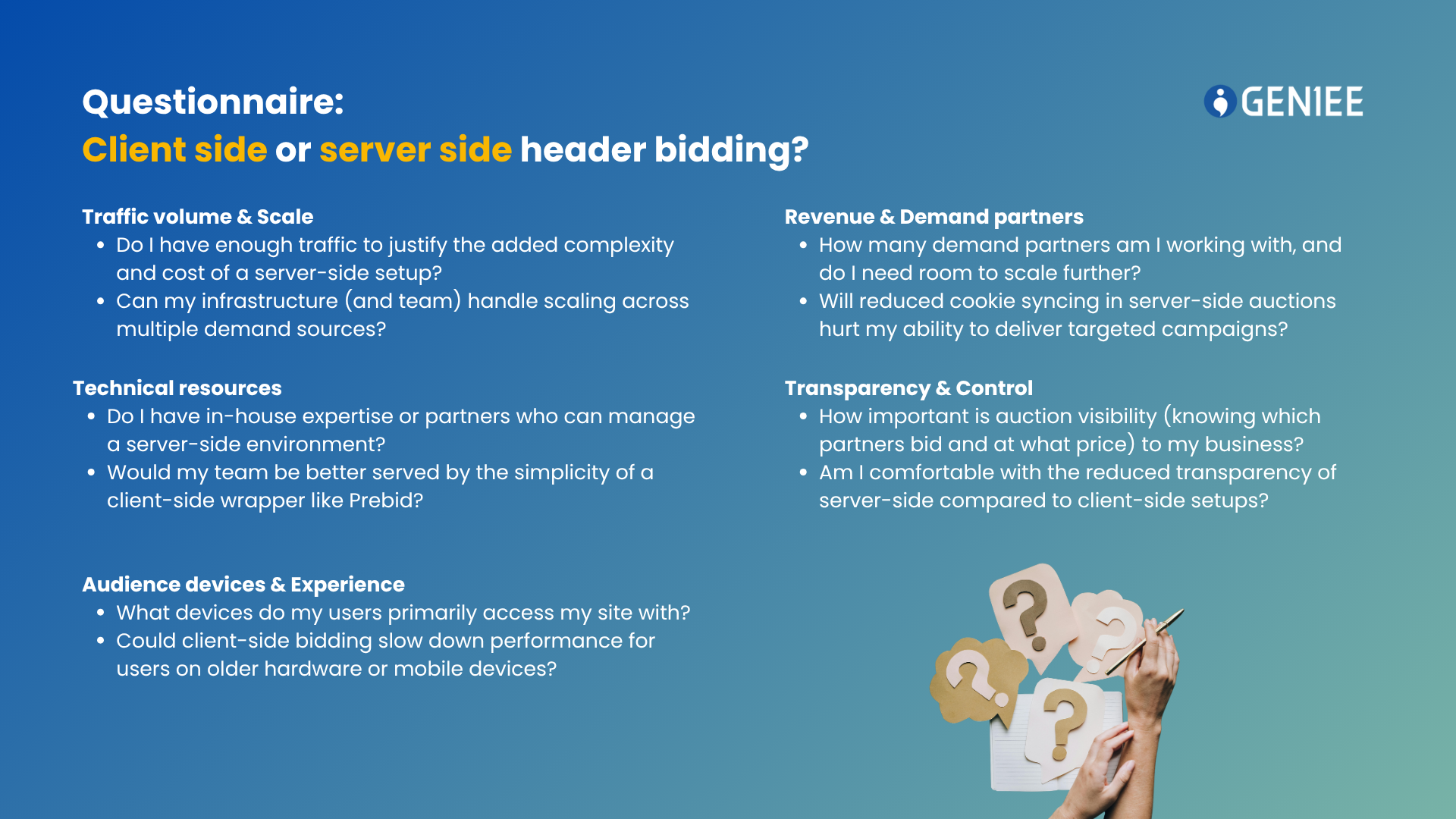Over the past few years, the rise of header bidding has significantly changed the way publishers manage their advertising stacks. More recently, many monetization teams have started weighing the idea of moving their Prebid auctions from the client side to the server side.
This article examines the advantages and disadvantages of both models. Afterwards, it outlines key criteria to help publishers decide on which one is the best match for their organizations.
What is header bidding?
Header bidding is an advanced programmatic advertising technology. It allows publishers to offer their ad inventory to multiple ad exchanges and demand partners simultaneously, in an auction format before the ad server is contacted.
As a result, it maximizes the publisher’s ad revenue by securing the highest possible price. It is considered an innovative replacement of the older, sequential method known as “waterfall”.
Learn more about the definition of header bidding and Prebid here.
What is client side heading bidding?
This concept is also known as “browser side header bidding”. It involves adding a piece of JavaScript in between the tags on a publisher’s site. This code, afterwards, will send an ad request to several demand partners. When bids start coming in from DSPs (via ad exchanges and SSPs), the highest bidder will win the auction.
How does client side header bidding work?
- A user enters the publisher’s URL in their browser.
- The browser begins loading the webpage.
- A header-bidding JavaScript wrapper embedded in the page executes and sends bid requests directly to multiple demand partners.
- These partners return their bids in real time to the browser.
- The highest bid is selected and forwarded to the publisher’s ad server.
- Inside the ad server, that bid competes with the publisher’s direct campaigns and other line items.
- The ad server chooses the overall highest-value option, and the winning ad is displayed on the page.
Pros of client side header bidding
What are the benefits that client side header bidding brings to publishers?
Easier setup and management
For most publishers, client side header bidding is simpler to implement than server-side alternatives. With widely adopted wrappers such as Prebid maintained by third parties, publishers can integrate header bidding with minimal technical overhead. This ease of deployment and lower maintenance burden make it the more practical choice for a majority of use cases.
Richer user insights
Because the auction takes place in the browser, SSPs gain direct access to user-side data. Through tracking pixels, they can legally capture details like IP address, browser type, and other contextual signals. These insights enable advertisers to better understand audiences, improving targeting and retargeting capabilities.
Stronger cookie matching
With client side auctions, vendors can sync cookies in the browser, which adds to advertisers’ ability to recognize users across sites. This improved identity resolution supports more precise targeting, which is often translated into higher CPMs, as advertisers pay a premium for audiences they can clearly identify.
Greater transparency and wrapper control
Client side setups also allow publishers to retain visibility over demand sources and auction dynamics. Header-bidding wrappers act much like tag managers that publishers add or remove demand partners, set bid timeouts, and track clearing prices. While switching wrappers can be complex, the overall transparency they provide offers publishers more confidence and flexibility in managing their monetization stack.
Pros of client side header bidding
What are the benefits that client side header bidding brings to publishers?
Easier setup and management
For most publishers, client side header bidding is simpler to implement than server-side alternatives. With widely adopted wrappers such as Prebid maintained by third parties, publishers can integrate header bidding with minimal technical overhead. This ease of deployment and lower maintenance burden make it the more practical choice for a majority of use cases.
Richer user insights
Because the auction takes place in the browser, SSPs gain direct access to user-side data. Through tracking pixels, they can legally capture details like IP address, browser type, and other contextual signals. These insights enable advertisers to better understand audiences, improving targeting and retargeting capabilities.
Stronger cookie matching
With client side auctions, vendors can sync cookies in the browser, which adds to advertisers’ ability to recognize users across sites. This improved identity resolution supports more precise targeting, which is often translated into higher CPMs, as advertisers pay a premium for audiences they can clearly identify.
Greater transparency and wrapper control
Client side setups also allow publishers to retain visibility over demand sources and auction dynamics. Header-bidding wrappers act much like tag managers that publishers add or remove demand partners, set bid timeouts, and track clearing prices. While switching wrappers can be complex, the overall transparency they provide offers publishers more confidence and flexibility in managing their monetization stack.
Cons of client side header bidding
Latency issues
Header bidding originally is designed to reduce the number of passbacks that made waterfall auctions inefficient. However, the client side implementation of header bidding is still not perfect.
When it adds a number of scripts in the page header, page-load times get longer. This negatively affects the user experience and leads to fewer impressions loaded.
Also, as client side header bidding involves establishing multiple connections to other servers (AdTech platforms), it can lead to additional problems for users with a slower internet connection.
Compatibility
Client side header bidding runs directly in the browser. This means it must work across many browsers, including older versions. As a result, compatibility issues can arise. In addition, some browsers may group external pixel requests together or even block them. When that happens, header bidding can become less efficient.
Risk of duplicated bids
In client side header bidding, a publisher connects to multiple header partners, so there is a risk of offering the same impressions multiple times for sales. This can lead to duplicate bid processing. However, it is important to note that this can also happen in server side implementations.
Slowdown in performance
Because client side header bidding executes additional logic directly in the browser, it can increase page load times and strain device resources. While this impact is often negligible on modern hardware, it may cause noticeable slowdowns for users on older devices or smartphones.
Vulnerability to auction malpractices
Since it is controlled by the user, not a renowned vendor, client side implementation leaves much space for possible shady techniques. It can hardly be fully transparent for all parties involved.
Processes such as data validation should be done server side, not client side, as client side data submission can be faked to avoid validation logic.
Limited ad requests
Auctions in client side header bidding run directly in the user’s browser, they are constrained by the browser’s ability to handle simultaneous requests. Most browsers can only process a limited number of network calls at once, which means the header-bidding wrapper can typically reach a limited number of demand partners.
What is server side header bidding?
Server side heading bidding is relatively newer compared to client side. The key difference is that requests are sent from a central server, not directly from the user’s browser.
Therefore, this approach, while maintaining the critical advantages of client side header bidding, can address several challenges associated with it, such as latency.
How does server side heading bidding work?
The workflow of server side header bidding can be broken down into the following steps:
- The user enters the publisher’s URL and opens the site.
- The browser requests and begins rendering the page.
- A lightweight header-bidding script on the page initializes and sends an auction request to the server side header bidding (SSHB) vendor.
- The SSHB server fans out bid requests to multiple demand partners/SSPs.
- Returned bids are evaluated server side; the top bid is packaged and sent to the publisher’s ad server.
- Inside the ad server, that bid competes against the publisher’s direct deals and other eligible line items.
- The ad server selects the highest-value line item and serves the winning creative, which the browser renders on the page.
Pros of server side header bidding
Reduction of latency issues
Server side header eliminates the need for multiple JavaScript tags, therefore reducing the latency problems associated with traditional header bidding. It enables faster loading of ads and improves user experience.
Better compatibility for videos and rich media ads
Because this approach offloads the intensive auction process from the user’s browser to a third-party server, it improves page latency and improves page load times for resource-heavy content, such as video and rich media ads.
Furthermore, server side header bidding is essential for monetizing video on platforms like Connected TV (CTV) and Over-the-Top (OTT) devices. These platforms are often incompatible with client side solutions.
Potentially higher CPMs
Server side header bidding offers greater scalability by allowing more demand partners to participate simultaneously without overloading the browser. This results in increased competition and higher CPMs for publishers.
Cons of server side header bidding
What are the potential drawbacks of this approach?
Lack of control and transparency
While the floor price in an auction is set by the publisher, the publisher can’t choose the buyers. The auction process remains “hidden” on the server.
With client side implementation, publishers can choose the buyers using the header-bidding wrappers. However, the server side method doesn’t offer such transparency for publishers.
Difficulties in identifying users
Server side header bidding makes user identification more challenging. The auction occurs on an external server, not the user’s browser. As a result, it limits direct access to user cookies and browser data needed for accurate user syncing across demand-side platforms (DSPs).
Limited adoption and trust
Server side header bidding is more scalable and can handle more demand sources. However, its implementation requires technical knowledge and ad tech professionals that may be scarce to find. Therefore, for a majority of online publishers, this can be a complex process. The entry cost of server side may outweigh its revenue uplift in comparison to client side bidding.
Client side vs Server side in header bidding – Which one is better?
There is no one-size-fits-all answer to the question of whether client side or server-side header bidding is better. The right approach depends largely on the specific circumstances of each publisher.
| Criteria | Client side is a better choice if: | Server side is a better choice if: |
| Traffic & Scale | You have moderate traffic and a manageable number of demand partners. | You run high-traffic sites and need to scale across many demand sources. |
| Technical resources | Your team has limited technical expertise; you rely on third-party wrappers like Prebid. | You have strong ad tech expertise (or partners) to manage complex server setups. |
| Audience devices & UX | Your users often use mixed/older devices where simplicity is key. | Your audience is mostly on modern devices, and you want to reduce browser load. |
| Revenue & Targeting | Cookie syncing and granular audience insights are central to your monetization strategy. | You prioritize scalability and partner diversity, even if cookie matching is weaker. |
| Transparency & Control | You want full visibility into auction bids, clearing prices, and demand partners. | You’re willing to trade off transparency for performance and scale. |
| Future-proofing | You’re optimizing for current market conditions and direct cookie-based targeting. | You’re preparing for a possible cookieless future and willing to invest in infrastructure now. |
| Overall fit | Best for small to mid-sized publishers, or those focused on control and data. | Best for large publishers with resources to invest in infrastructure and long-term growth. |
In addition, publishers can also refer to this list of questions that will help them decide which approach is more suitable for their organizations.

Conclusion
Ultimately, the decision should be guided by a publisher’s inventory type (e.g., display vs. video), demand relationships, available technical expertise, and current market trends. For many publishers today, the optimal path may not be a complete shift in one direction but rather a hybrid approach that leverages the strengths of both models. For example, they can consider using client side for its transparency and data access while adopting server-side selectively for scalability and performance.




0 Comments